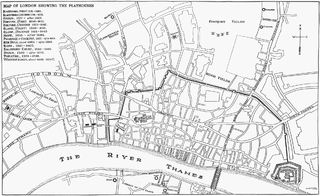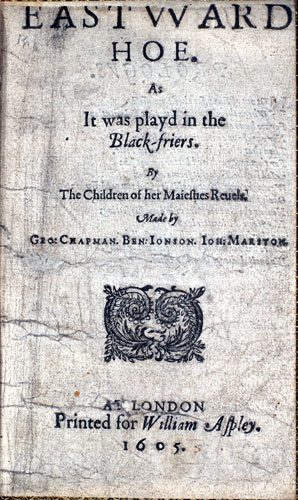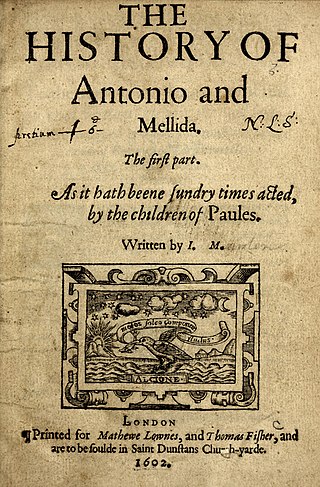Synopsis
The court of Duke Pietro of Genoa is abuzz with talk of their mysterious new guest, Malevole. While not in his chamber performing discordant music, Malevole spends his time openly criticizing the court and its courtiers, steadfastly refusing to engage in any sort of flattery. While this earns him the ire of many, he is embraced by Pietro, as he "gives good intelligence" to his spirit, and makes him "understand those weaknesses which others flattery palliates." Having earned Pietro's trust and respect, Malevole reveals that Pietro's wife, Aurelia, has been carrying on an affair with Pietro's adopted heir and protégé, Mendoza. Malevole further incites Pietro against the pair by declaring the situation most unnatural, as cuckolding is a creation of woman rather than God, and by highlighting the incestuous nature of the adultery.
As the enraged Pietro rushes off to confront Mendoza, Malevole meets with his friend Celso. It is revealed that Malevole is, in fact, Altofronto, the former Duke of Genoa, deposed in a political coup staged by Mendoza on behalf of Pietro, made powerful through an alliance with Florence solidified by his marriage to Aurelia. Malevole, with the help of his spy Celso, has been learning the strengths, weaknesses, and secrets of his enemies, biding his time in the usurper's court until the opportune moment to strike presents itself. While Malevole schemes in Genoa, his wife Maria has been imprisoned, faithfully awaiting his return.
Meanwhile, Pietro confronts Mendoza, accusing him of treachery and adultery. Although Pietro threatens to kill him. Mendoza, knowing that Aurelia has not only been unfaithful with him, but also with the courtier Ferneze, shifts the Duke's attention, revealing Ferneze's treachery. He convinces the Duke to break into Aurelia's chambers; if he should find Ferneze there, and he attempts to flee, that should serve as proof of their adultery. For the most part, Mendoza's plan works, yet unbeknownst to him Ferneze is not killed but escapes, injured. The wounded Ferneze seeks out Altofronto, seeking aid and protection, both of which the former Duke provides.
Later, Mendoza and Aurelia plot to murder Pietro, with Aurelia promising to use her influence with Florence to have Mendoza appointed Duke of Genoa after her husband's death. Mendoza approaches Malevole to carry out the murder while Pietro is away hunting. Malevole accepts the task and gifts Mendoza two boxes, both of which contain fumes. The fumes of one box cause those who inhale to fall into a deep, deathlike sleep for twelve hours. The fumes of the second cause instant death. Impressed by Malevole's seeming willingness to aid him in his plans, Mendoza divulges his master plan. After Pietro's murder and his dukedom secured by Aurelia, he will publicize her infidelities and subsequently have her banished, making room for him to take Maria as a wife in order to solidify his claim over Genoa. Through Celso, Malevole knows that Maria, still faithful, has no part in Mendoza's schemes. He suggests they manufacture a witness to testify to seeing Pietro, anguished over Aurelia's infidelities, throw himself into the sea, in order to avoid any implication in his death and bolster Mendoza's claims of her infidelity.
Malevole finds Pietro and informs him of Mendoza's plot against him. He disguises him as a hermit and directs him to testify to witnessing his own death. Pietro does as much, and more, lamenting Aurelia's repeated adulteries. Upon hearing his testimony, Mendoza immediately exiles Aurelia, and orders Malevole to deliver terms of marriage to Maria. He also instructs Malevole to murder the disguised Pietro, while at the same time ordering Pietro to murder Malevole. The pair subsequently encounters Aurelia outside Genoa, anguished over the apparent death of Pietro and guilt-stricken over her infidelity. Malevole counsels forgiveness, as many a great man, from Arthur to Hercules, has been the victim of adultery. Pietro acquiesces. Maria is subsequently proved faithful when she rejects Mendoza's offer of riches for her hand in marriage, declaring that regardless of circumstances, Altofronto is her true husband.
Recognizing that the only remaining figure capable of challenging his power is Altofronto, Mendoza uses the lethal box given to him by Malevole to poison him. Though the box turns out to be empty, Altofronto feigns death. Mendoza then accuses Maria of the murder of the hermit, the disguised Pietro, to which Maria responds she would gladly embrace death rather than marry a usurper.
Mendoza throws a lavish masquerade ball to celebrate his rise to power. In attendance are all his supposed victims. At an appointed time, Altofronto, Pietro, and Ferneze all reveal themselves, and Mendoza's schemes are brought to light. Altofronto takes his rightful place as Duke. Mendoza, begging for his life, is exiled, and Pietro and Aurelia are reconciled.
The Malcontent tells the story of the deposed duke Altofront, who has adopted the alter ego of Malevole, a discontented parasite, in order to try to regain his lost dukedom. Malevole is an angry satirist-figure, who attacks the corruption and decadence of the court in which he lives. The degree to which the play is a comment on the court of James I and the immorality of his courtiers is debatable, as the satire is, by and large, general enough to fit any court. However, The Malcontent seemed to some contemporaries to be, like Marston's later plays, a lashing of the new, bumptious, and corrupt Scottish courtiers, and some specific satire is certain. Although Marston warns in his introductory epistle "some things I have willingly erred, as in supposing a Duke of Genoa, and in taking names different from that city’s families", some scholars believe that Marston intended the Genoa presented in The Malcontent to be an accurate historical depiction of the actual city. Domenico Lovascio argues that the rapid-fire succession of leaders in the play is an accurate reflection of the historically politically unstable city, a city rife with corruption, treachery, and plots. [3]










